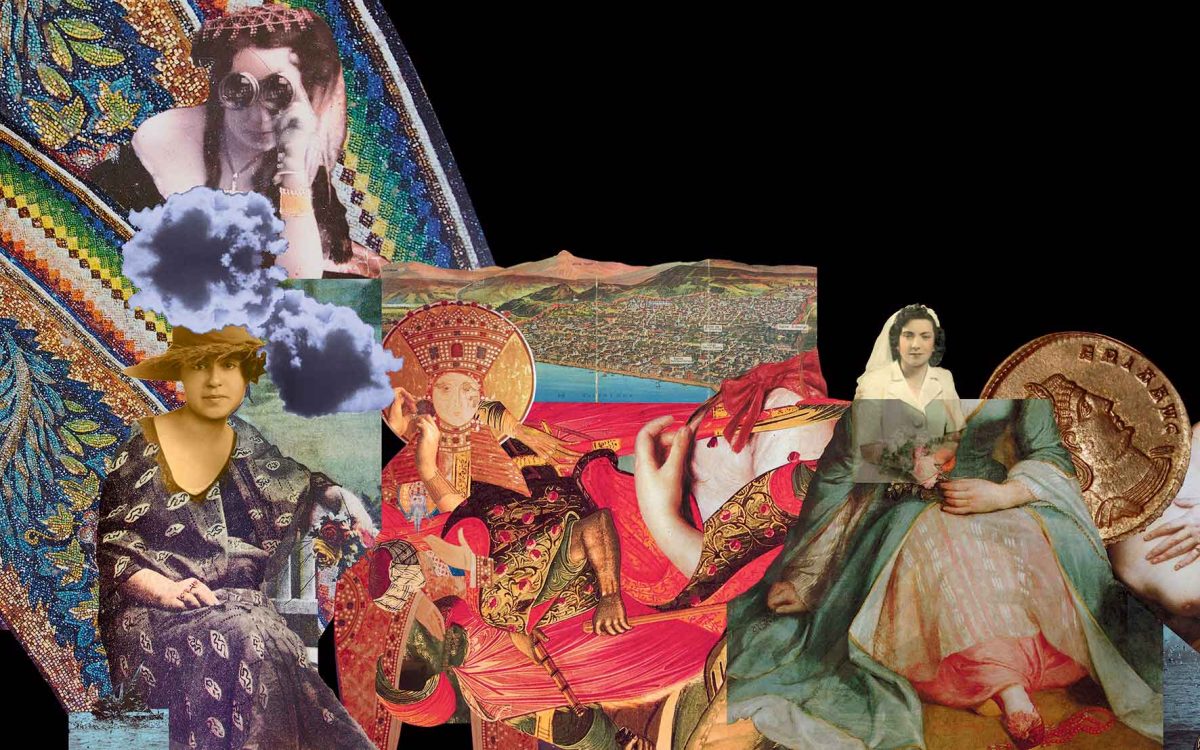Thessalonike, Simonida, Valeria, Zoe Kareli: what do these names conjure up, if anything? And what if I’d asked instead about the half-sister of Alexander the Great, the daughter of Byzantine Emperor Andronikos II Palaiologos, the wife of Roman Emperor Galerius, and the sister of author Nikos Gabriel Pentzikis, respectively? The more I ponder the question, the more I come to realize that not only has history been written by men, but that – generally speaking – women are imprinted in our minds merely as reflections of great men. So, I ask myself, what would it be like to hear the stories of these women, with men in a peripheral role for once?
This is the different look at history offered by the city sightseeing tour from Thessaloniki Walking Tours. I’m intrigued by the concept, but my initial enthusiasm regarding the female side of history will soon be dispelled as I learn about the dark, heartbreaking, and even horrific aspects of the women’s lives, beginning first with Thessalonike, the woman who gave her name to the city.
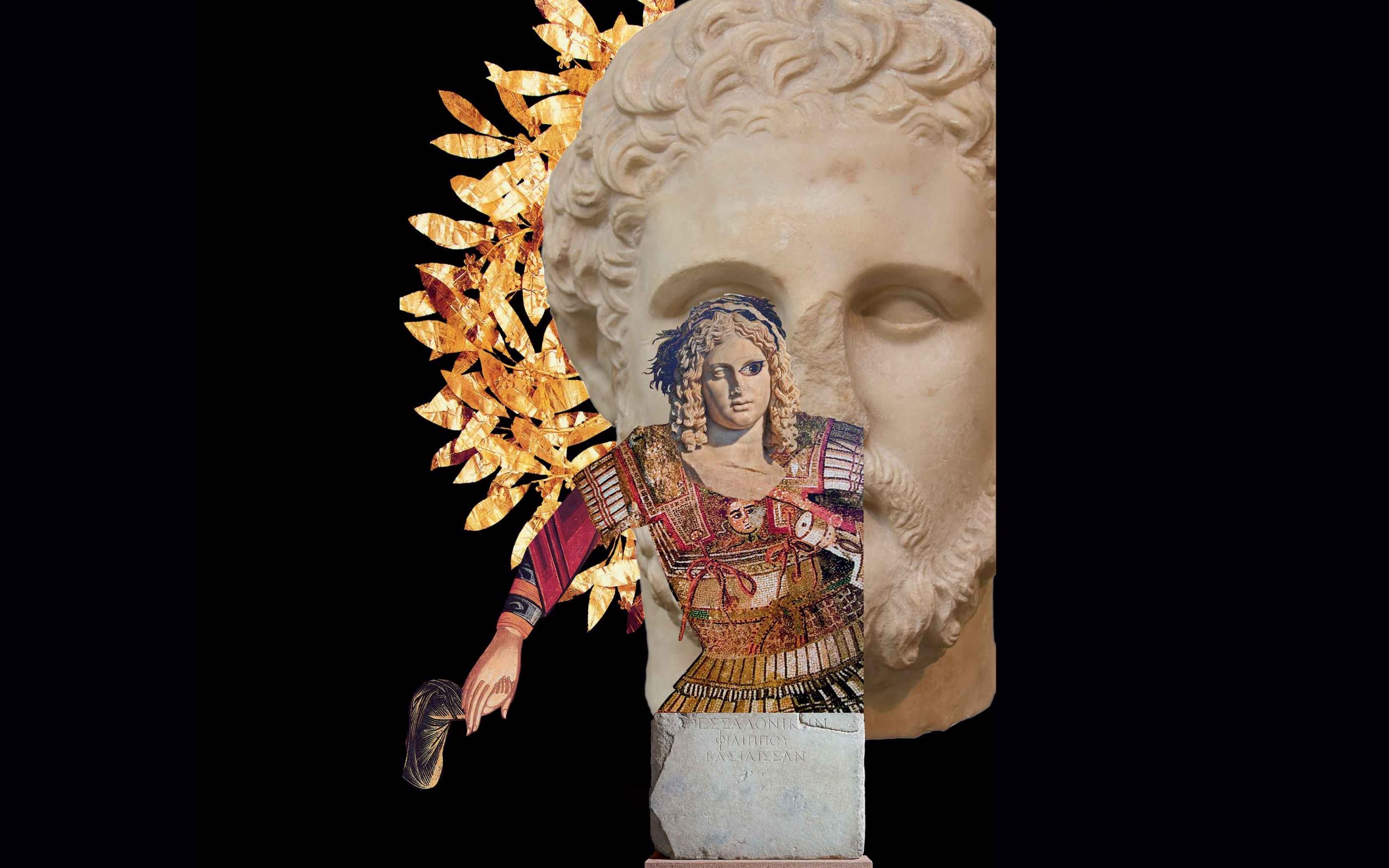
© Collage art by Dimitris Tsoumplekas
The woman behind the name
I’m standing across the road from the Ministry of Macedonia-Thrace, with Tasos Papadopoulos, a Thessaloniki Walking Tours guide. We’re looking at ruins below street level, trying to make out a recently discovered building dating from the Hellenistic period. “Here, from the ancient ruins of a city that has been inhabited uninterruptedly for centuries, we shall unravel the thread of its founding and, we hope, find some traces of Thessalonike the woman. Unfortunately for us locals, the historical figure is now little more than a legend created in medieval times,” my guide says with a sad shrug. Indeed, the tale of how the sister of Alexander the Great became a mermaid and searched the seas for her dead brother is familiar to many Greeks, and it’s a popular subject in the fine arts as well.
“Born around 345 BC,” Papadopoulos continues, “Thessalonike was the daughter of King Philip II of Macedon and half-sister to Alexander the Great. Her tragic fate was foreshadowed at a very early age when she lost her mother while still an infant. Some scholars believe that she was brought up by her stepmother, Olympias, mother of Alexander. Unusually, despite her royal lineage, she remained unmarried. When Alexander died in Babylon, sparking the Wars of the Diadochi (“Successors”), Cassander – who is considered the founder of the city of Thessaloniki, – fought against Olympias, defeating her in the great siege of ancient Pydna, an important commercial center of the time located south of Thessaloniki.
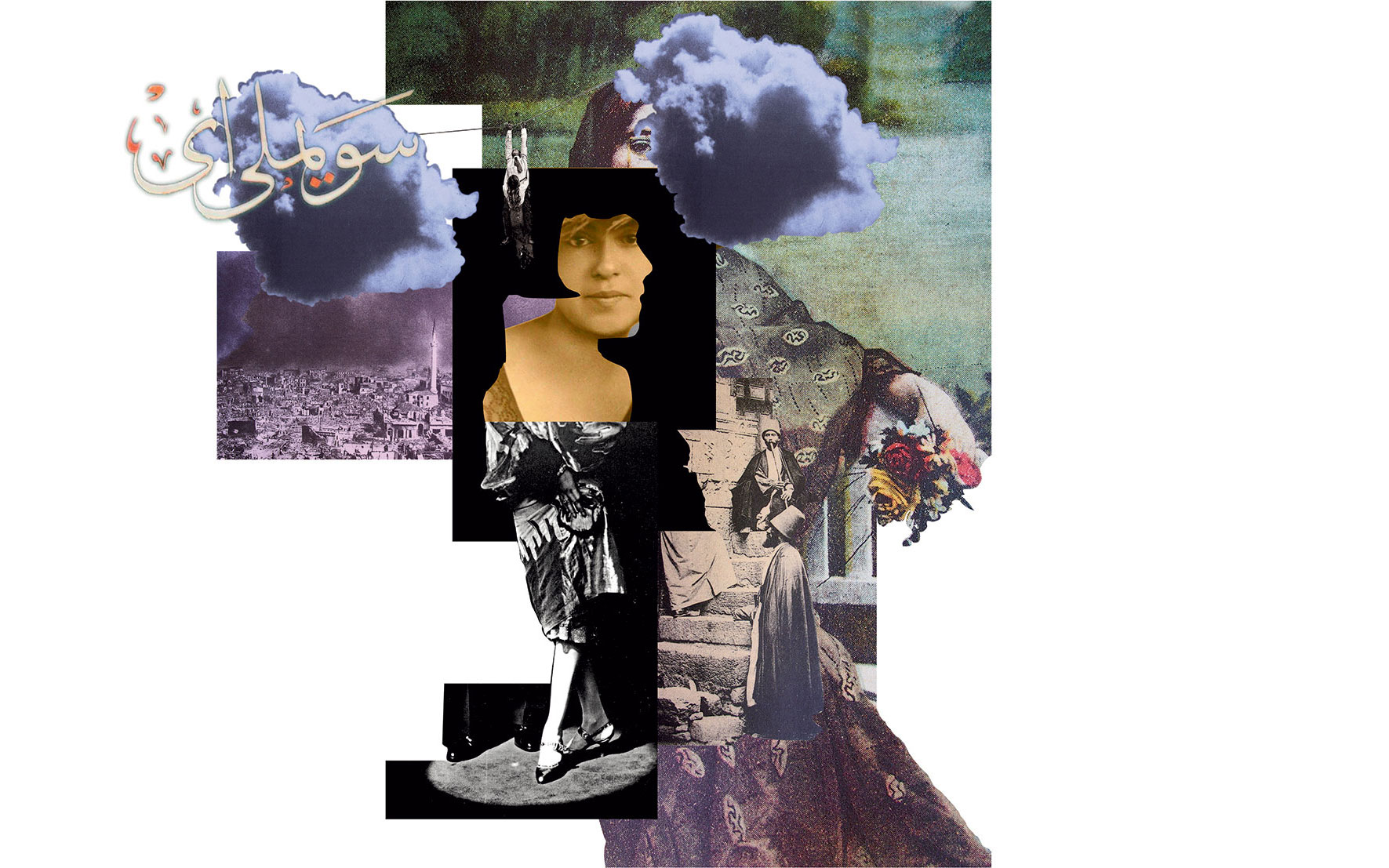
© Collage art by Dimitris Tsoumplekas
After having Olympias killed, Cassander forced Thessalonike to marry him and then had Alexander’s wife Roxana and their son, Alexander IV, murdered. He later joined together 26 small settlements around the Thermaic Gulf and founded the city in 316-315 BC, naming it after his wife. It is perhaps ironic that his own name was given to Cassandreia, today a small tourist town of Halkidiki. Cassander and Thessalonike had three sons. When Cassander died, the three brothers vied for power, resulting in the murder of Thessalonike at the hands of her own son, Antipater II. Nearly two thousand years later, her life became the subject of a 17th-century Italian opera, “La Tessalonica.”
Papadopoulos reveals something that may explain why Thessalonike has faded from our collective memory: we do not know what she looked like. He goes on to describe how the slab of a large pedestal was discovered during excavations in the Roman Agora, bearing the inscription “Queen Thessalonike – [Daughter] of Philip,” and next to it two more slabs with inscriptions dedicating the missing statues, one to Alexander the Great and the other to Alexander his son (murdered by Cassander). “In the Archaeological Museum of Thessaloniki, there’s an interesting marble head that was found very close to the pedestal slabs which remains unidentified. There is disagreement among archaeologists; some believe it’s an Alexander, albeit of an atypical type, while others argue that it may be the face of Thessalonike. If this is indeed the case, it is probably the only depiction we have of her from the entire ancient world,” Papadopoulos says with undisguised pleasure.
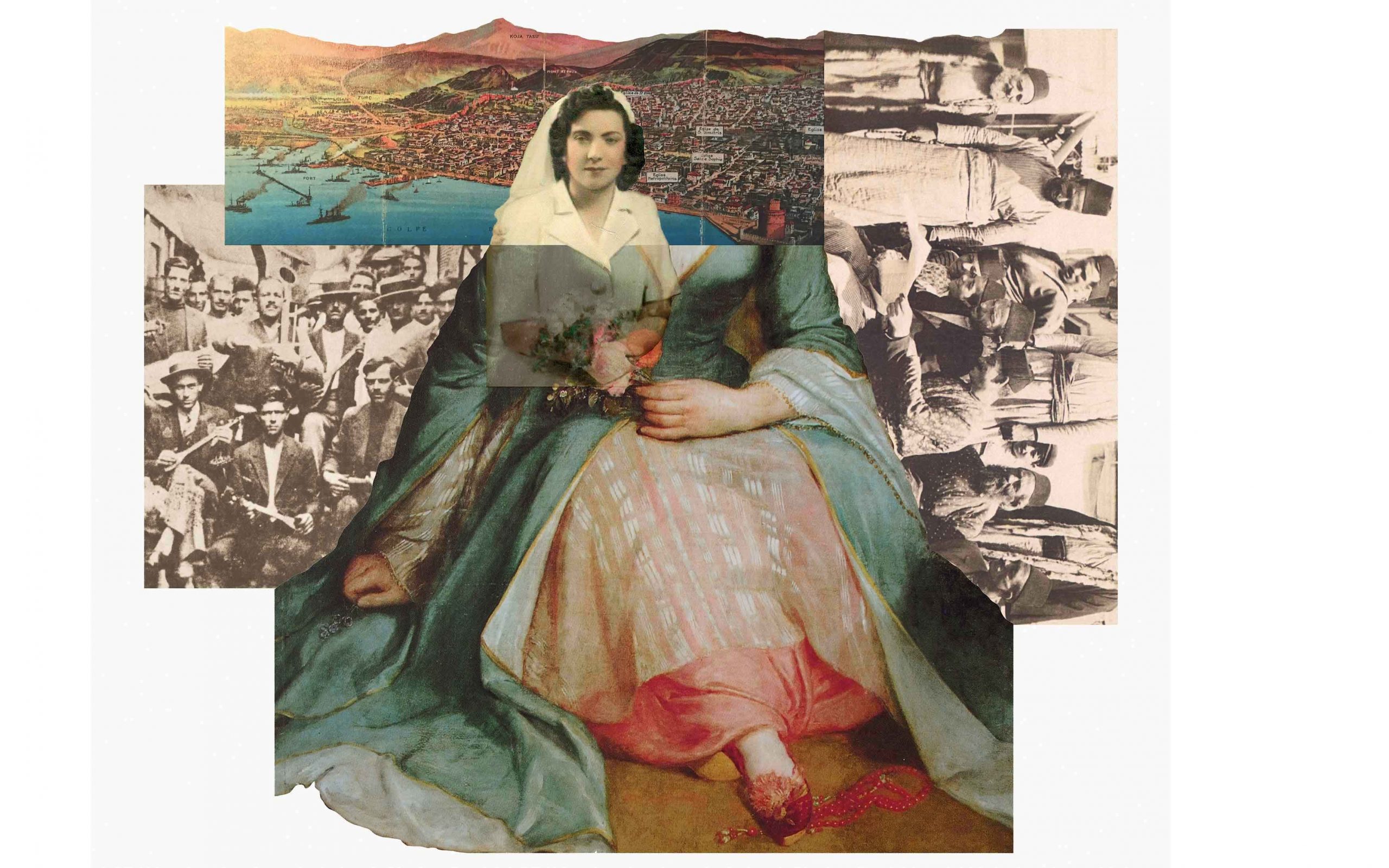
© Collage art by Dimitris Tsoumplekas
A pioneer in print
City tours can at times appear to lack substance, with the fragments of the stories often lacking a link to reality, as if the concrete has swallowed up the last fragments of memory. But not this one. For I have the good fortune to be accompanied by an individual who is not only well read, but also has the gift of being able to transform the city, through his descriptions, into a vibrant scene from the distant past. Beneath the asphalt I “see” ancient wars; in the buildings and neighborhoods I “see” historic quarters; and in every monument I “see” all those cities that once existed in this part of the modern-day city.
In the Aghios Dimitrios neighborhood, Papadopoulos transports me to the beginning of the last century. As we walk past the elementary school on Kassandrou Street, I can imagine our next heroine ascending the steps to the school entrance. Her name is Sabiha Sertel (1895-1968). Until today, I’d never even heard of this amazing woman, who was born in Thessaloniki, became the first professional female journalist and publisher in Turkey, and was active in the campaign for women’s rights in New York in the 1920s.
Her family were members of the Dönmeh community, Jews who converted to Islam while privately retaining their Jewish faith. It was a group with conservative principles and strict rules of endogamy, but Sabiha managed to escape the suffocating atmosphere in which she had grown up and became the first woman to marry a man from outside the Dönmeh, the Turkish journalist Zekeriya Sertel. Together, they moved to Istanbul and started a newspaper, one contributor to which was the celebrated Turkish poet Nazim Hikmet, also born in Thessaloniki. Sabiha’s professional career in Turkish journalism came to a premature end when, after the death of Atatürk, she and her husband came under attack as the result of their strong criticism of the government for its pro-Nazi stance. They would spend the rest of their lives in self-exile in various European cities. Sabiha Sertel died and was buried in Baku, Azerbaijan.
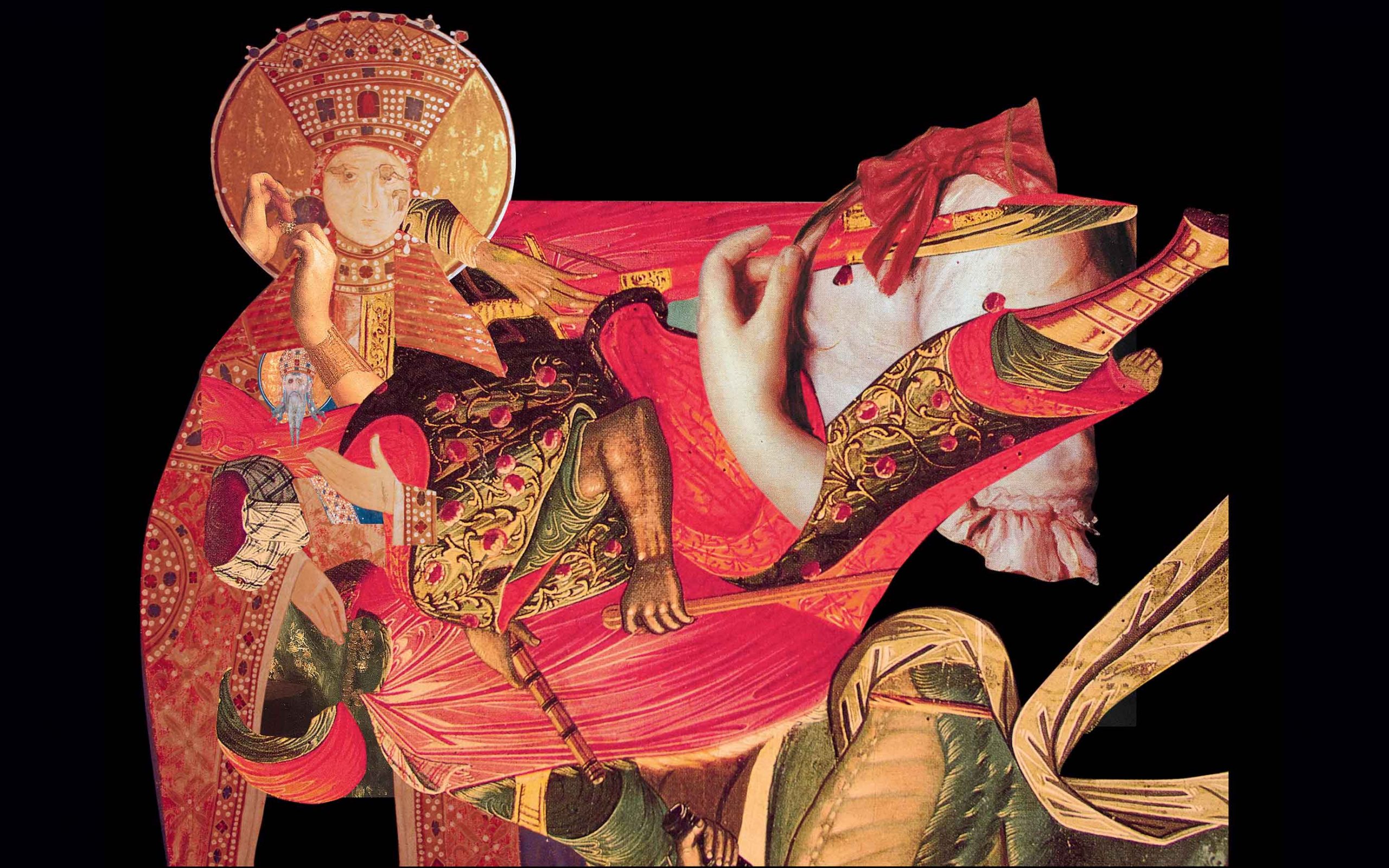
© Collage art by Dimitris Tsoumplekas
Child bride
As we make our way down Aghiou Nikolaou Street towards the Church of Aghios Dimitrios, I notice the small chapel of Aghios Efthymios for the first time. Its ktetor, or patron, my guide informs me, was Michael Doukas Glabas Tarchaneiotes, a noted general who served under Byzantine Emperor Andronikos II Palaiologos. Papadopoulos spoke at length about this man and how he funded the decoration of the chapel’s walls as part of his appeal for divine help in fathering a child. But nothing prepares me for the horrific story of the church beside it.
In the late 13th century, the militarily weak Byzantine empire came under attack from the King of Serbia, today considered a saint in the Serbian Orthodox Church, Stefan Milutin. Unable to defeat him, the Byzantines resorted to diplomacy and looked to arrange an alliance by marriage. But they’d need a Byzantine bride to save the empire and stop Milutin’s army from reaching the gates of Constantinople. They found her in the person of the emperor’s daughter, Simonida. She was aged just five, and I can picture her, adorned as a bride, arriving here at the Church of Aghios Dimitrios (where the wedding ceremony is gen- erally assumed to have been held) to meet the fierce Milutin. The saddest part of the story is that, according to Byzantine sources, the warlike monarch immediately consummated the marriage; this act would render Simonida unable to bear children. When her mother died, the young bride returned to Constantinople, but she was soon forced to go back to Milutin, staying with him until his death in 1321, after which she spent the rest of her life as a nun.
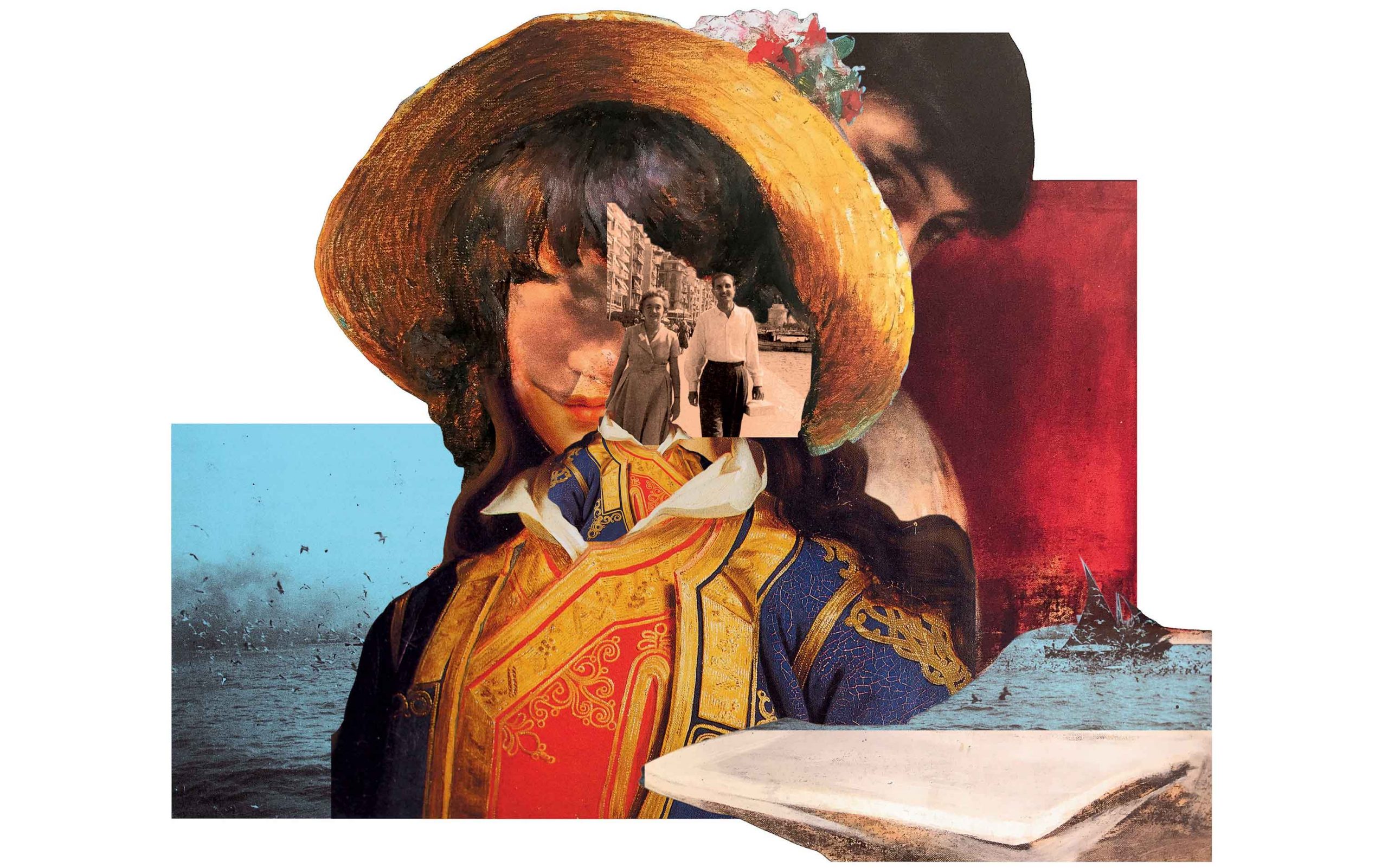
© Collage art by Dimitris Tsoumplekas
Giving voice
After hearing this story, I’m in low spirits indeed. To lift them, Papadopoulos plays a song on his phone, a popular old rebetiko piece by Vassilis Tsitsanis: “She may have been seduced by seashores and sunsets, which keep her poor heart enslaved forever.” It’s a favorite of mine, but I know nothing about the woman behind the sensuous voice until the guide explains it’s Stella Haskil, a Sephardi Jew, born in Thessaloniki in 1918.
We head down to the area of Athonos Square with its ouzo bars and small tavernas, where she probably performed for the first time, like so many other singers and musicians in the city. She stood out thanks to her inimitable voice and, shortly after the liberation in 1944, began to make a name for herself in Athens, alongside great composers of the rebetiko and urban popular genres who wrote songs specifically for her, including Tsitsanis, Apostolos Kaldaras, Manolis Chiotis and Markos Vamvakaris. She left her mark on the history of Greek recorded music with 135 songs, but sadly died at just 36 years of age.
Poet
Now we’re making our way to Aghia Sofia Square. I don’t know if it’s because of all the tales I’ve been hearing, but I can certainly imagine the literary cafés of the not-too-distant past that once stood here, frequented by some of the city’s most famous figures. Among them was Chrysoula Argyriadou, née Pentziki (1901-1998), whose pen name was Zoe Kareli. Despite living in the shadow of her younger brother, the author Nikos Gabriel Pentzikis, she still won first prize in the State Poetry Awards (1974), became the first woman of letters to be elected to the Academy of Athens (1982), and was awarded the title of Commander of the Order of the Phoenix of the Hellenic Republic (1985). Papadopoulos wants to talk about her poem “Human” (from the collection Antitheseis, 1957) and how she became the first Greek woman in the modern era to explore gender issues in her poetry.
Human
I, a woman, a female human, sought Your face always;
it was, till now, a man’s,
and I cannot know it differently.
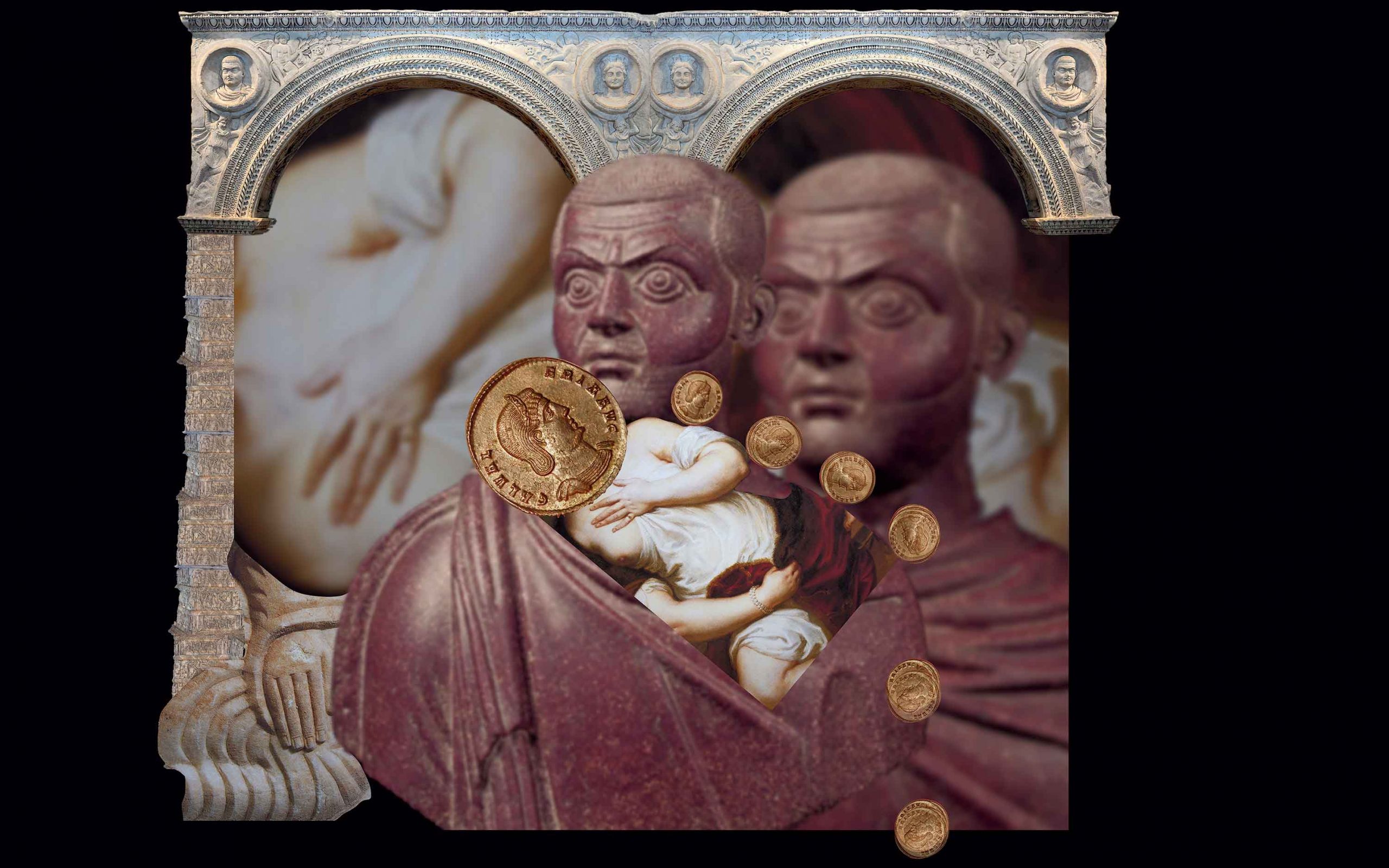
© Collage art by Dimitris Tsoumplekas
Canceled queen
Our walk ends in front of the Octagon, at the back of Navarino Square. “Here, let’s remember a woman who suffered what in Latin is called ‘damnatio memoriae,’ that is, condemnation of memory. In other words, efforts were made to eradicate all traces of her, as if she’d never existed.”
Empress Valeria (who died in AD 315), of whom Tasos is speaking, was the wife of Galerius, the Roman emperor whose life is commemorated all over the city, for example by the Rotunda, the Arch of Galerius and the Galerian Complex. Valeria’s marriage was arranged by her father, Diocletian, after which she spent her life confined to the palace and never gave birth. When Galerius died in 311, she wandered the East for some time before finally settling in Thessaloniki. However, she was later found and beheaded in the central square of the city; her body was dismembered and thrown in the sea.
It was here, at the Octagon, that archaeologists discovered the Small Arch of Galerius. At the top, on either side, there are two tondi, one depicting the emperor and the other Valeria. Her face and the jewelry that would have denoted her imperial status have been erased while, in a later intervention, a mural crown has been added on her head. It would appear that she’s been transformed from an empress to an abstract personification of the city, removing all memory of her person.
The tour leaves me with a sense of disquiet about just how much pain the women of the city have suffered. But at the same time, I’m grateful for the chance to overturn the condemnation of memory, restore the standing of women, and learn more about them. Papadopoulos and I both agree that Thessaloniki should have at least one landmark for the woman after whom it was named, one artwork in commemoration of the commendable women associated with the city. If this isn’t vital to ensuring the validity of the historical narrative, then what is?

